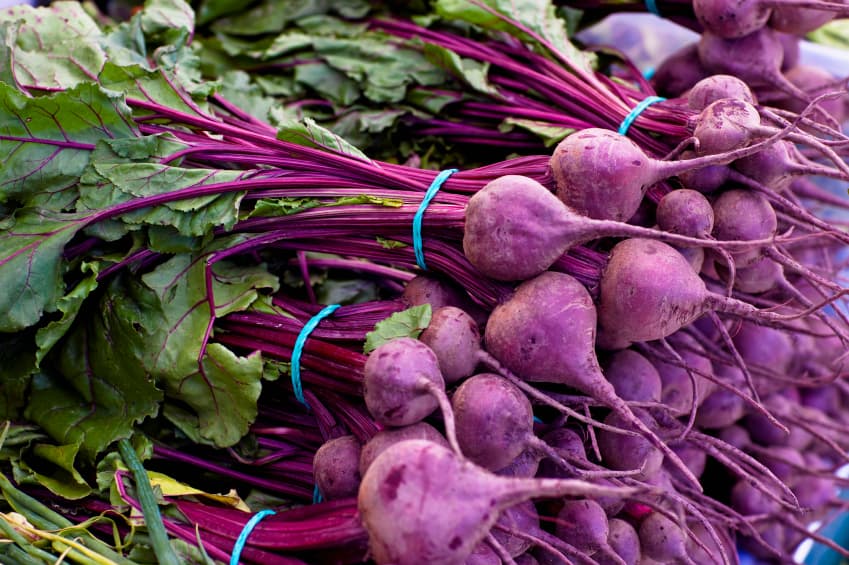I’m willing to bet you’ve never heard someone say, “Beets are okay.” If you mention beets to someone, you’ll either get a cringe of loathing or a spontaneous smile with an audible “Mmmmmm.” For some reason they’re just one of those vegetables people either love or hate.
I’m lucky enough to be of the Mmmmmm variety. Why does this make me so lucky? Well, for starters, beets are packed with nutrition. According to Sally Fallon Morell’s Nourishing Traditions, this beauty of a vegetable is packed with:
- Iron
- Copper
- Calcium
- Phosphorus
- Potassium
- Carotene
- B complex
- Vitamin C
No slouch, right? We always hear that the deeper in color our vegetables and fruits are, the more nutrition they provide. And you can’t get much deeper and richer in color than red beets. Of course red is only the most familiar hue—beets come in other gorgeous colors as well.
Beets are not only pretty to look at and delicious to eat, but they’re also incredibly versatile. Roast them for a side dish, puree them into a soup like borscht, dice them up and add them to a green salad. Heck, you can even grate them for use in a chocolate cake. I love them all.
Sally Fallon Morell also offers up the great tip to buy your beets with the leafy-green tops still attached. This way you’ll know they’re still fresh, plus the edible greens are just as good for you as the beet itself. Simply sauté them in butter and/or olive oil, and add some onions and garlic if you like. One taste and you’ll wonder why you ever threw them away in the past.
The Selene River Press Historical Archives is a great resource for all kinds of nutritional information, and the beet is no exception. In The Red Beetroot Juice, E.L. David points out several exceptional ways the beet can improve your health when you need it most. Standard Process uses cold-processed juice from beet leaves and roots in a number of their whole-food supplements, most famously in Betafood. With their blood-building qualities, beets have been used in the treatment of leukemia patients. They’ve been cited as a method to enhance healing after X-ray and radiation exposure. And because of their high iron content, beets are also effective in combatting anemia.
For my next adventure with beets I’ll be trying beet kvaas—a lacto-fermented beverage revered as a digestive aid and liver cleanser. It can also alkalize the blood. You can drink it straight up or use it in place of vinegar in a salad dressing. While lacto-fermenting can be a bit intimidating, Maria Atwood makes it seem incredibly simple in her Cook Your Way to Wellness DVD. Being the visual learner that I am, this great tool will give me confidence to start my first batch.
Beets are such a nutritional powerhouse that you owe it to yourself to get on the “Mmmmmm” side of the debate—if you’re not already. But if you do tend to cringe instead, there’s such a wide variety of ways to get beets in your diet that you should be able to find one that will sway your feelings. Since this is a common and economical vegetable that stores well and can be found year round, it should be a piece of cake—literally, if you choose—to try beets in different recipes until you find the one for you.
For all you fans out there, what’s your favorite way to enjoy this glorious root?
Photo from iStock/LOVE_LIFE




I love Detroit golden beets…well, all beets really. Anyway you prepare them, they are wonderful! I like golden beets with a little fresh frisée, clover sprouts, maybe some creme fraiche, and a corn pancake underneath. I could write about beets for weeks. I planted 9 varieties this year … I’ll be pickling, canning, puréeing my heart out…
That sounds fantastic, Cupertino!! I don’t believe I’ve ever had Detroit golden beets but a grocer here in town uses a golden beet of some kind in one of my favorite salads. Beautiful and delicious! Nine varieties of beets in your garden? Man, it sounds like it must be a sight to see! Enjoy them and thank you for taking the time to read and comment on my post. I appreciate it! :)